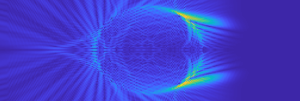Observing how light interacts with materials allows us to develop non-invasive medical imaging techniques, that rely on these interactions to assemble an image or infer an appropriate diagnosis.

Light interacts with materials in many different ways. One of the most commonly observed interactions is dispersion; which causes white light to split into individual colours, creating phenomena like rainbows (light from the sun dispersing through raindrops). Another commonly observed interaction is refraction; which causes light to change direction as it passes between two materials, responsible for straight objects like straws appearing to be disjointed when placed into water. To completely describe what is going on in these interactions, we have to use a system of equations known as Maxwell’s equations. We also have to consider some additional parameters that describe the particular material(s) that the light is interacting with. In their most general form, Maxwell’s equations are very complex but have the advantage that almost all materials and interactions can be modelled by them. Solving these equations is, in general, impossible to do with pen and paper, so we need software to do this for us.
Software like this has a wide variety of applications in biomedical optics; notably optical coherence tomography (non-invasive medical imaging of the eye), multiphoton microscopy, and wavefront shaping. For example; we can use this software to model light propagating in the retina: simulating a retina scan. Then we can perform a retina scan for a patient in real life, and use our simulation to better understand the scan. Retinal scans often hint at a particular change to the retina, without being definitive, in the early stages of disease. We can use our simulation to test what types of changes to a retina can lead to observed signatures in an image and therefore help in achieving a diagnosis.
The Problem
In collaboration with the UCL Medical Physics and Biomedical Engineering department, developers from ARC have worked to open up a legacy C and MATLAB library which simulates light propagating through matter. This software was initially developed as part of a PhD thesis approximately 20 years ago and has been continuously developed since then. However, the need to rapidly answer research questions led to the code becoming less sustainable and harder for others to use. Whilst the core functionality was already there; the library needed updating to a more modern language and aligning with the FAIR4SW principles.
What we did
The aim of the project was to be able to provide users with a program that they can give custom input which describes the material they want to simulate, pass this to the software and receive an output they can use in further analysis. We wanted users not to have to worry about the internal workings of the software; only having to download the library code, build and install it once, and be ready for future analyses. We used modern build tools to standardise the build and install of the software, we aimed to make our instructions as straightforward and operating-system-independent as possible. We also set up automated testing of the software and wrote example scripts that users can modify to easily create input files in the correct format.
The outcomes
Version 1.0.1 of the Time Domain Maxwell Solver (TDMS), is now available under a GPL-3.0 license. You can download from GitHub, and install and run on all operating systems. The project has a public-facing website and a growing collection of examples. We also have developer documentation so anyone can contribute in the future.
TDMS 1.0.1 now has a number of new features, including the option to switch between different solver methods (how the simulation is performed), select custom regions over which to compute (to save wasting computation time), and the ability select different techniques for extracting output information through interpolation.
The ARC software engineers were a joy to work with. They brought knowledge of modern software engineering practice and quickly understood the code, and the underlying physics, as required to very effectively re-engineer the code. This collaboration with ARC will hopefully allow for a new range of users to access TDMS and significantly increase its impact.
—
Will Graham and Sam Cunliffe


 Close
Close


